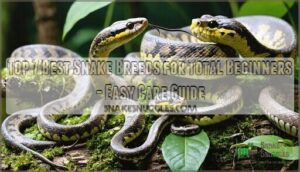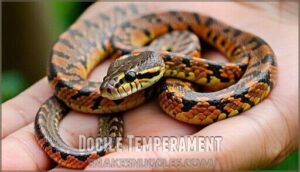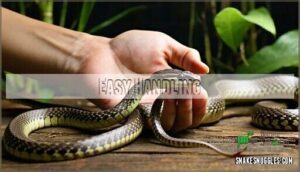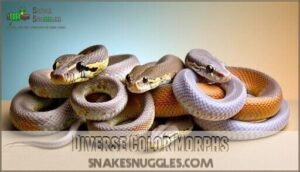This site is supported by our readers. We may earn a commission, at no cost to you, if you purchase through links.

These species offer docile temperaments, manageable sizes, and straightforward care requirements that won’t overwhelm new reptile owners.
Corn snakes lead the pack with their forgiving nature and stunning color variations, while ball pythons provide that "wow factor" without aggressive tendencies.
Each species brings unique characteristics—from the rosy boa’s compact size to the garter snake’s active personality.
Your choice depends on space constraints, handling preferences, and aesthetic appeal.
The secret lies in matching specific traits to your lifestyle and comfort level.
Table Of Contents
- Key Takeaways
- Top 7 Snake Breeds for Total Beginners
- Corn Snakes: The Ideal Starter Pet
- Ball Pythons: Gentle Giants for Novice Owners
- Rosy Boas: Compact and Low-Maintenance Companions
- Kingsnakes: Colorful and Hardy Beginner Snakes
- Garter Snakes: Active and Entertaining First Pets
- Sand Boas: Burrowing Beauties for New Owners
- Choosing Your First Snake: Factors to Consider
- Frequently Asked Questions (FAQs)
- What is the most recommended snake to have as a pet?
- Which snake loves to be held?
- What is the most beginner friendly snake?
- What snake is easiest to breed?
- What is the most chill snake to own?
- What is the most affordable snake?
- How do I handle a snake that doesnt want to eat?
- What are the signs of a stressed or sick snake?
- How often should I clean my snakes enclosure and accessories?
- What are the best ways to provide mental stimulation for snakes?
- Conclusion
Key Takeaways
- You’ll find corn snakes and ball pythons lead the pack for beginners – they’re incredibly docile, rarely bite, and forgive care mistakes while you’re learning proper snake handling techniques.
- Most beginner species require simple 20-30 gallon setups with basic heating, hiding spots, and weekly feeding schedules that won’t overwhelm your budget or living space.
- You’re committing to 20-30 years of care when choosing species like ball pythons or rosy boas, so consider your long-term lifestyle and space availability before purchasing.
- Your choice should match your handling comfort level – start with ultra-gentle corn snakes if you’re nervous, or choose ball pythons if you want an impressive yet manageable "wow factor" pet.
Top 7 Snake Breeds for Total Beginners
Choosing your first pet snake doesn’t have to feel overwhelming. Beginner snake breeds like corn snakes and ball pythons dominate recommendation lists for good reason—they’re forgiving, docile, and straightforward to care for.
These beginner friendly species won’t bite the hand that feeds them (literally). When researching top snake breeds, focus on manageable sizes, simple feeding schedules, and calm temperaments.
Check reptile laws in your area first, then explore beginner snake forums for real-world advice. Consider pet snake costs beyond the initial purchase: enclosures, heating, and ongoing snake feeding guide requirements.
The right snake care routine becomes second nature with these hardy pet snakes.
Corn Snakes: The Ideal Starter Pet
If you’re thinking about getting your first snake, corn snakes should top your list for good reason.
These North American natives combine everything beginners need: a forgiving temperament, straightforward care requirements, and enough personality to keep things interesting without overwhelming new owners.
Docile Temperament
Corn snakes possess remarkably gentle nature that makes them perfect beginner snake breeds.
Corn snakes’ remarkably gentle nature makes them perfect beginner snake breeds.
These docile serpents exhibit calm behavior during snake handling sessions, rarely displaying aggression or defensive postures.
Their pet friendliness shines through consistent temperament tests, showing they’re truly low-maintenance snakes.
Here’s what makes their docile temperament shine:
- Freeze response – They remain still rather than strike when startled
- Tolerance buildup – They recognize familiar handlers and become increasingly relaxed
- Stress indicators – Minimal hissing, tail-whipping, or defensive coiling during interactions
Easy Handling
When handling corn snakes, you’ll discover their docile temperament makes them incredibly easy to handle. These beginner snakes respond well to gentle touch and calm movements.
Their low maintenance doesn’t mean careless—proper handling techniques matter.
| Handling Aspect | Best Practice |
|---|---|
| Session Duration | Start with 5-10 minutes |
| Grip Technique | Support body, avoid head |
| Frequency | 2-3 times weekly maximum |
| Timing | Never after feeding |
| Movement | Slow, deliberate motions |
Their calm temperament means less stress for both of you during these interactions.
Diverse Color Morphs
Beyond their gentle nature, corn snakes offer stunning breed variations that make them living masterpieces.
Color patterns range from classic reds and oranges to mesmerizing lavenders, snows, and anerythristic morphs.
Morph genetics have created over 800 documented varieties, giving you endless pet aesthetics options.
Popular morphs include the vibrant okeetee, ghost, and candy cane varieties.
While snake camouflage patterns in wild corn snakes help them blend with forest floors, captive-bred morphs showcase brilliant colors that pop against any terrarium backdrop.
Choose based on your visual preferences—each morph has identical care requirements.
Feeding Requirements
Your corn snake’s dietary needs couldn’t be simpler.
These adaptable reptiles thrive on frozen/thawed mice, making feeding requirements straightforward for beginners.
Here’s your feeding roadmap:
- Prey Selection: Choose mice matching your snake’s thickest body section
- Meal Frequency: Feed juveniles every 5-7 days, adults every 7-10 days
- Food Sizes: Start with pinkies for babies, graduate to adult mice
This feeding schedule supports proper growth while preventing overfeeding issues.
Habitat Setup
Setting up your corn snake’s enclosure design requires three essential components. Use a 20-30 gallon tank with secure lid for snake enclosure basics. Substrate choices include aspen shavings or cypress mulch for burrowing comfort.
Create temperature gradients using heating options like under-tank heaters. When designing the enclosure, consider the importance of proper snake enclosure materials for safety and comfort.
| Component | Specification | Purpose |
|---|---|---|
| Tank Size | 20-30 gallons | Adequate space for movement |
| Heating Options | Under-tank heater, 85°F basking | Temperature regulation |
| Substrate Choices | Aspen shavings, 2-3 inches deep | Burrowing and comfort |
| Hide Boxes | Two secure shelters | Security and stress reduction |
Humidity control stays around 40-50% naturally. No special lighting systems needed—ambient room lighting works perfectly for these adaptable snake habitat conditions.
Ball Pythons: Gentle Giants for Novice Owners
Ball pythons earned their reputation as "gentle giants" because they’re naturally calm and rarely show aggression, making them perfect for nervous first-time snake owners.
These docile serpents rarely strike when startled, making them perfect confidence-builders for anxious beginners.
You’ll find their manageable 3-5 foot size strikes the ideal balance between being impressive enough to wow friends while staying comfortable to handle during routine care, which is a key factor for many owners who want a manageable pet.
Calm Disposition
Ball pythons earn their reputation as gentle giants through their naturally docile temperament.
You’ll find these calm species respond well to consistent, gentle handling, becoming increasingly trusting over time.
Their gentle nature makes them ideal easy-to-handle snakes for beginners.
Watch for relaxed body posture and slow movements – signs of their inherently calm temperament that defines these low-maintenance snakes.
Manageable Size
When considering space needs for ball pythons, you’ll find they’re surprisingly manageable for beginnerfriendly snakes.
Adults reach just 3-5 feet, making them perfect small species for novices.
Their compact enclosures require only 20-30 gallon tanks, fitting easily into most homes.
This small size combined with their docile temperament creates lowmaintenance, easytohandle pets that won’t overwhelm your living space or budget.
Lifespan and Growth
Your ball python partner starts as a palm-sized hatchling but grows into a 3-5 foot adult over three to four years.
These snakes offer incredible snake longevity, living 20-30 years with proper care. Growth rates slow after maturity, and their aging process is gradual. Understanding these health factors helps you plan for decades together.
Key Growth and Longevity Facts:
- Snake lifespan: 20-30 years average with exceptional care
- Snake growth: Reaches adult length by 3-4 years old
- Snake size: Males typically smaller (3 feet) than females (4-5 feet)
- Size limits: Growth plateaus around maturity, no continued expansion
- Snake longevity: Consistent temperatures and proper nutrition maximize lifespan
Dietary Needs
Feeding habits are delightfully straightforward with ball pythons.
These snakes thrive on frozen prey – typically mice or small rats matching your snake’s thickest body width.
Meal frequency varies by age: juveniles need weekly meals while adults eat every 2-3 weeks.
Their dietary needs remain consistent throughout life, making feeding requirements predictable.
Snake diet simplicity means less guesswork and more confidence for new owners managing snake feeding frequency.
Understanding the proper snake diet basics is vital for maintaining a healthy ball python.
Enclosure Essentials
Creating a proper home for your ball python involves more than just grabbing any tank from the pet store. Your snake’s enclosure setup directly impacts its health, behavior, and overall well-being throughout its decades-long lifespan.
Essential Components for Success:
- Tank Size: A 20-30 gallon terrarium provides adequate space for juvenile ball pythons, while adults need 40+ gallons
- Substrate Options: Choose reptile carpet, cypress mulch, or paper towels—avoid cedar shavings which cause respiratory issues
- Heating Systems: Install under-tank heaters or ceramic heat emitters to maintain 80-85°F ambient temperature with a 90°F basking spot
- Hiding Spots: Provide two identical hides (warm and cool sides) so your python feels secure while thermoregulating
Climate Control Essentials:
Humidity Control requires maintaining 50-60% relative humidity using a digital hygrometer and occasional misting. Ventilation Requirements include mesh tops with adequate airflow to prevent stagnant air and mold growth. Lighting Needs are minimal since ball pythons are nocturnal, but a day/night cycle helps regulate natural behaviors.
Monitor temperatures with digital thermometers on both sides of your snake enclosure to confirm proper gradients.
Rosy Boas: Compact and Low-Maintenance Companions
If you’re looking for a snake that won’t take over your living space, rosy boas are your perfect match.
These pint-sized serpents max out at just 3 feet long, making them ideal for apartment dwellers or anyone who wants all the joy of snake ownership without needing a mansion-sized enclosure.
Small Size Advantages
Rosy Boas pack big personality into small species that won’t overwhelm total beginners.
These miniature habitats require just 20-gallon tanks, saving precious space in apartments or dorms.
Compact enclosures mean lower setup costs and easier maintenance.
Their manageable 2-3 foot length guarantees handling ease – perfect for new keepers building confidence.
Space savings make these docile snakes ideal lowmaintenance snakes for cramped living situations.
Feeding Schedule
You’ll find feeding these compact companions refreshingly simple—they only require meals every 10-14 days. This relaxed meal frequency makes rosy boas perfect for busy beginners.
Offer appropriately-sized frozen-thawed prey; prey size should match the thickest part of your snake’s body. Their slow metabolism means you won’t stress about constant feeding times like with other pets.
While they don’t need food variety, maintaining proper snake nutrition is vital. Monitor your snake’s body condition to adjust snake feeding frequency as needed.
This predictable snake feeding schedule helps you plan ahead while meeting their snake dietary needs and snake nutritional needs effortlessly.
Temperature and Humidity Needs
Your rosy boa thrives when you nail their temperature and humidity needs. These desert natives prefer ambient temperature ranges of 75-85°F during daylight hours, dropping naturally to 65-75°F at night.
You’ll want to create thermal gradients using under-tank heaters controlled by thermostats—think of it as giving your snake choices, like picking the perfect spot on a beach. Heat control becomes straightforward with proper equipment. Position your heat source on one end to establish temperature regulation across the enclosure.
Your snake will cruise between warm and cool zones as needed. Here’s your moisture management checklist:
- Maintain humidity levels between 10-30% using digital hygrometers
- Avoid temperature fluctuations above 10°F to prevent stress
- Provide adequate ventilation to prevent respiratory issues
These arid-adapted beauties can’t handle excessive moisture like their tropical cousins. Too much humidity creates a breeding ground for problems you’d rather avoid. Understanding proper snake care is essential for their well-being.
Handling Tips
When you’re ready to handle your rosy boa, remember that gentle touch makes all the difference. Always support techniques that distribute the snake’s weight evenly across your hands—never grab just the head or tail.
Use both hands to cradle their body, letting them feel secure as they might engage in natural snake wrapping around your forearm. Watch for snake body language cues like rapid tongue flicking or defensive posturing, which signal stress.
If you’re nervous about snake handling, consider handling gloves initially, though bare hands provide better grip and connection. Safety precautions include avoiding handling sessions right after feeding or during shedding periods when they’re most vulnerable.
Start with short five-minute sessions to minimize snake handling stress. These handling techniques become second nature with practice, and your rosy boa will learn to trust your consistent, calm approach to snake handling precautions. Investing in proper snake handling gloves can greatly reduce the risk of snake bites during handling.
Lifespan Considerations
When you welcome a Rosy Boa into your home, you’re making a Pet Commitment that could span decades. These beginner snake species offer remarkable Snake Longevity, living 20-30 years with proper care.
Understanding this long lifespan helps you prepare for the Owner Responsibility ahead and makes Breed Selection easier for total beginners.
Your snake’s lifespan expectancy depends on several key factors that shape their health journey:
- Age Factors at purchase: Choose captive-bred specimens at least 6 months old for better health outcomes and established feeding patterns.
- Nutritional foundation: Provide appropriately-sized frozen-thawed prey every 10-14 days to support healthy growth throughout their extended lifespan.
- Environmental stability: Maintain consistent temperatures (75-85°F daytime) and humidity levels (30-40%) year-round for ideal physiological function.
- Preventive healthcare: Schedule annual veterinary checkups and monitor for common issues like respiratory infections or parasites that could impact longevity.
This decades-long journey makes snake breeds like Rosy Boas perfect companions for committed first-time owners.
Kingsnakes: Colorful and Hardy Beginner Snakes
Kingsnakes offer stunning diversity with over 50 distinct color morphs ranging from classic black and white bands to vibrant reds, yellows, and even solid patterns that’ll make your friends do a double-take.
You’ll appreciate their bulletproof constitution and straightforward care needs, making them perfect for beginners who want a visually striking snake without the headaches of finicky species.
Vibrant Patterns and Colors
Kingsnake enthusiasts can’t help but marvel at these serpents’ stunning diversity. With over 50 morphs available, you’ll discover incredible hue variation from classic black-and-white bands to exotic lavender phases.
Color morphs result from specific pattern genetics—albino morphs lack melanin, creating pink and yellow tones, while high-white variations showcase dramatic scale shine. These vibrant patterns serve as natural snake camouflage in wild habitats.
Popular snake breeds include granite morphs with speckled earthtones and cinnamon varieties displaying warm golden hues. Each colorful snake represents unique genetic combinations, making kingsnakes among the most visually diverse snake colors in captivity.
The unique scale patterns are a result of iridescent scale effects that create mesmerizing light reflections, showcasing the stunning diversity of kingsnakes and their ability to display vibrant patterns.
Feeding Habits
Every successful kingsnake owner masters prey selection and feeding frequency for ideal snake nutrition.
You’ll feed frozen-thawed rodents every 7-10 days, matching food size to your snake’s girth to prevent digestion issues.
Snake feeding essentials include:
- Pre-killed mice or small rats sized appropriately
- Consistent weekly feeding requirements schedule
- Room temperature thawing before offering prey
- Monitoring your snake’s body condition regularly
Enclosure Requirements
Your kingsnake needs a 20-30 gallon tank with secure, ventilated lid—these escape artists will find any weakness.
Choose aspen shavings or cypress mulch for substrate choice.
Install ceramic heat emitters or under-tank heating to create proper thermal gradients.
| Component | Specification |
|---|---|
| Tank Size | 20-30 gallons minimum |
| Heating Options | Ceramic emitters, UTH |
| Substrate Choice | Aspen shavings, cypress |
| Ventilation Systems | Screen tops, air vents |
Temperament and Handling
Reading your kingsnake requires understanding snake behavior. While generally docile, each snake’s temperament differs. Watch for stress signals like body tension or hissing during animal interaction.
First-time snake owners should start with brief sessions, gradually building trust. Here are key handling tips for total beginners:
- Support the body completely when lifting
- Move slowly to avoid triggering defensive responses
- Avoid handling during shedding or after feeding
Pet psychology shows consistent, gentle snake handling builds confidence in both owner and snake over time.
Health Considerations
Why not keep your kingsnake thriving with proper health management?
These hardy snakes need attention in three key areas:
- Veterinary Care: Schedule annual reptile vet checkups to catch snake diseases early and establish baseline health metrics.
- Parasite Control: Watch for weight loss or unusual stool changes that signal internal parasites – regular fecal testing reduces infestations substantially.
- Environmental Health: Maintain proper temperatures and humidity to prevent respiratory infections, feeding issues, and hydration management problems that compromise snake health.
Garter Snakes: Active and Entertaining First Pets
If you’re looking for a snake that’s anything but boring, garter snakes might be your perfect match.
These active little hunters bring personality and entertainment to beginner snake keeping while remaining surprisingly easy to care for.
Natural Behaviors
Garter snakes showcase fascinating natural behaviors that make them charming first pets.
These active hunters use hunting tactics like ambushing and quick strikes to catch prey.
When stressed, they’ll release a musky scent – their signature defense mechanism.
Unlike solitary species, garter snakes display snake social tendencies through territorial marking and snake communication via body language and chemical signals during interactions.
Dietary Variety
Unlike most snake species that thrive on a single prey type, garter snakes require food variety to maintain ideal health.
Their diverse appetites mirror wild hunting patterns, making feeding more engaging for both you and your pet.
Prey Options include:
- Earthworms and nightcrawlers – excellent protein sources that stimulate natural foraging behaviors
- Small fish like guppies or minnows – provide essential fatty acids but require vitamin B1 supplements
- Frozen-thawed pinkie mice – convenient protein option that’s nutritionally complete
- Insects and amphibians – crickets, small frogs offer dietary enrichment when available
Feeding schedules should include 2-3 meals weekly for adults, with juveniles eating every 3-4 days. Snake prey size matters – offer items no wider than your snake’s thickest body section.
Dietary supplements become vital when feeding fish regularly, as thiaminase in fish depletes vitamin B1. This food variety prevents nutritional deficiencies common in captive garter snakes fed monotonous diets. Understanding garter snake diets is key to providing the best care for your pet.
Social Tendencies
Social Communication unfolds uniquely among garter snakes.
Unlike many reptiles, they display fascinating snake social behaviors through chemical signals and body positioning.
Their interaction styles include scent trailing and defensive postures that reveal individual personalities.
| Communication Type | Behavior Description |
|---|---|
| Chemical Signals | Tongue-flicking detects pheromones from other snakes |
| Body Language | Coiling patterns indicate stress or comfort levels |
| Territorial Marking | Scent deposits mark familiar areas and pathways |
| Group Dynamics | Occasional clustering during brumation periods |
| Recognition Patterns | Individual scent identification of cage mates |
Habitat Design
Creating the perfect snake habitat requires careful attention to three key components that’ll keep your garter snake happy and healthy.
Enclosure Size starts with a 20-gallon tank minimum, though larger is always better for these active serpents. Temperature Control means maintaining a gradient from 70-75°F on the cool side to 80-85°F for basking.
- Substrate Options include aspen shavings or cypress mulch for natural burrowing behavior
- Lighting Systems should provide UVB exposure during 10-12 hour daily cycles
- Humidity Levels need consistent 50-60% with proper ventilation to prevent respiratory issues
Handling Techniques
Once you’ve created the perfect home for your garter snake, learning proper handling techniques becomes your next priority. These active serpents require specific taming methods that respect their natural behaviors while building trust through gentle touch.
Here’s how to master snake handling with confidence:
- Support the entire body during snake interaction to prevent injury and reduce stress
- Watch for defensive posturing like coiling or rapid tongue-flicking before attempting contact
- Start with brief five-minute sessions to gradually build tolerance and familiarity
Remember these safety precautions: avoid handling during shedding periods when your snake’s vision is impaired, and never grab just the head or tail. Snake wrapping around your arm is normal behavior, not aggression.
These handling tips help first-time snake owners develop proper snake handling precautions while creating positive experiences for both handler and snake. Understanding garter snake care is essential for providing a suitable environment and handling your pet snake effectively.
Sand Boas: Burrowing Beauties for New Owners
Sand boas make perfect pets if you’re fascinated by snakes that spend most of their time buried in substrate like tiny, scaly submarines.
These small constrictors rarely exceed three feet in length and offer beginners a unique window into natural burrowing behaviors that other pet snakes simply can’t match, providing a fascinating glimpse into the life of small constrictors.
Unique Burrowing Behavior
Sand boas exhibit fascinating burrowing behavior that makes them perfect snake breeds for total beginners.
You’ll watch them use specialized digging techniques, disappearing into substrates to create intricate tunnel systems.
Their burrow design mimics natural desert habitats, requiring adequate substrate depth for proper snake enclosure design.
These unique features showcase their instinctual abilities perfectly.
Substrate Choices
Your snake substrate choices matter more than you might think.
Aspen Shavings work perfectly for sand boas, allowing natural burrowing while staying dust-free. Reptile Carpet offers easy cleaning and prevents impaction risks.
Avoid Sand Options and Wood Chips that retain Moisture Levels and cause respiratory problems.
Snake Paper Towels provide temporary solutions during cleaning, but dedicated Snake Substrate Choices like aspen create happier, healthier pets.
Feeding Methods
Mastering snake feeding methods guarantees your Sand Boa stays healthy and thrives. You’ll want to establish proper feeding schedules and choose between live prey and frozen foods based on your comfort level.
- Live Prey vs. Frozen Foods: Live prey triggers natural hunting instincts, but frozen-thawed prey is safer and more convenient. Snake thawed prey eliminates bite risks and parasites while providing complete snake nutrition.
- Food Sizes Matter: Choose prey matching your snake’s thickest body section. Proper snake prey size prevents regurgitation and guarantees safe digestion for peak health.
- Feeding Schedules: Adult Sand Boas eat every 7-14 days, while juveniles need weekly meals. These snake feeding methods create consistent routines your pet will appreciate.
Temperature Regulation
Your sand boa’s burrowing lifestyle demands precise temperature control through substrate heating.
Heat sources like under-tank heaters create essential thermal gradients, with ambient temperature staying 75-85°F while basking spots reach 90-95°F.
This temperature regulation mimics their desert habitat, ensuring proper digestion and activity patterns.
Proper temperature regulation involves understanding temperature control methods to create a suitable environment.
Temperature Range
Handling Precautions
Once you’ve established proper temperature gradients, gentle handling becomes your next priority for Snake Safety.
Your sand boa’s defensive behavior signals when it needs space, so watch for flattening or hissing before attempting contact.
Proper Snake Behavior observation prevents stress and supports Injury Prevention through these essential Handling Tips:
- Always support your snake’s body weight completely
- Move slowly with a Gentle Touch to avoid startling
- Wash hands before and after for hygiene
- Use secure containers for transport
- Never handle during shedding periods
This mindful approach creates positive snake handling experience while respecting your pet’s natural instincts.
Choosing Your First Snake: Factors to Consider
Before you pick your perfect serpentine companion, you’ll need to take into account several practical factors that determine success.
Your living situation, available time, and budget will guide you toward the species that fits your lifestyle best.
Space Requirements
Your snake’s enclosure size directly impacts its well-being and natural behaviors.
Most beginner species thrive in 20-30 gallon tanks, but tank dimensions matter more than volume alone.
Habitat depth becomes critical for burrowing species, while vertical height accommodates climbing behaviors.
When setting up a snake’s environment, considering the proper snake tank equipment options is essential for creating a suitable habitat.
| Species | Minimum Tank Size |
|---|---|
| Corn Snake | 20-gallon long |
| Ball Python | 40-gallon breeder |
| Rosy Boa | 20-gallon long |
| Kenyan Sand Boa | 20-gallon long |
| California Kingsnake | 30-gallon long |
Time Commitment
Beyond initial setup costs, Daily Care for snakes requires genuine Owner Dedication.
Feeding Schedules vary by species—some eat weekly, others biweekly. Handling Time builds trust but isn’t daily necessity.
Snake Maintenance includes spot-cleaning, temperature monitoring, and monthly deep cleans. First-time owners often underestimate this time commitment.
Snake ownership spans decades, so consider your long-term availability before choosing snake care as a hobby.
Budget Considerations
Beyond just time, your wallet deserves attention too. Snake ownership involves several financial commitments that smart planning can handle.
Initial costs include your snake and complete habitat setup, while ongoing expenses cover food, substrate changes, and veterinary care. Here’s your complete budget breakdown:
- Initial Costs: Snake ($25-$200) plus complete enclosure setup ($150-$400)
- Ongoing Expenses: Monthly substrate changes and quarterly supply replacements
- Food Budget: Frozen rodents cost $2-$5 monthly per snake
- Enclosure Costs: Heat sources, hiding spots, and water dishes
- Maintenance Fees: Annual vet visits ($75-$150) and emergency care reserves
The breakdown of these costs helps in understanding the financial implications of snake ownership, ensuring that potential owners are well-prepared for the responsibilities involved.
Local Laws and Regulations
Research snake ownership laws before purchasing your first reptile.
Permit requirements vary by state, with 61% requiring some form of regulation for exotic pets.
Legal restrictions often target large constrictors and venomous species, while beginner breeds like corn snakes remain legal in most areas.
Regulatory bodies and law enforcement actively monitor compliance, with violations resulting in $500-$5,000 fines and potential animal confiscation.
Personal Preferences and Lifestyle
Choosing your first snake ultimately depends on aligning the species with your Pet Ownership goals and Lifestyle Choices. Your comfort level with Snake Handling directly impacts which species you’ll enjoy most as firsttime snake owners.
Consider these essential factors for snake lifestyle compatibility:
- Snake handling comfort – Start with docile species like corn snakes if you’re nervous about handling
- Snake space availability – Measure your available area before committing to larger species
- Snake budget limits – Factor in initial costs plus ongoing feeding and veterinary expenses
- Travel frequency – Some species tolerate feeding delays better than others during vacations
- Family dynamics – Consider household members’ comfort levels and any existing pets
These Beginner Tips help guarantee your Space Needs match your chosen species for long-term success.
Frequently Asked Questions (FAQs)
What is the most recommended snake to have as a pet?
Corn snakes top every beginner’s list because they’re incredibly docile, eat reliably, and thrive in simple setups. You’ll find them forgiving of mistakes while learning proper snake care techniques.
Which snake loves to be held?
Ball pythons typically enjoy handling most among beginner-friendly species.
They’re naturally calm and often seem to relax when held properly.
Corn snakes also tolerate frequent handling well, making them excellent choices for interactive pet ownership, and are often considered beginner-friendly.
What is the most beginner friendly snake?
Corn snakes reign supreme for beginners—they’re docile, hardy, and rarely bite. You’ll appreciate their simple care needs, predictable feeding schedule, and stunning color varieties that make handling enjoyable.
What snake is easiest to breed?
Here’s your breeding breakthrough: corn snakes take the crown for easiest reproduction.
You’ll find their straightforward mating rituals, reliable egg-laying, and hardy offspring make them perfect for your first breeding adventure, with straightforward mating rituals and reliable egg-laying being key advantages.
What is the most chill snake to own?
Ball pythons reign as the most chill snake you’ll own.
They’re naturally docile, handle stress well, and rarely bite.
These gentle giants adapt quickly to handling and stay calm during routine care, making them perfect for relaxed ownership.
What is the most affordable snake?
Rosy boas offer the best bang for your buck, often priced around $25- You’ll find them incredibly affordable to purchase and maintain, with minimal setup costs and simple care requirements.
How do I handle a snake that doesnt want to eat?
First, check if your snake’s stressed by environmental factors like incorrect temperatures, humidity, or recent habitat changes.
Try offering prey at night when they’re most active, make certain proper heating gradients, and wait patiently between feeding attempts.
What are the signs of a stressed or sick snake?
When your snake’s under the weather, you’ll spot telltale signs quickly. Look for appetite loss, lethargy, irregular shedding, respiratory issues like mouth-breathing, unusual postures, or behavioral changes indicating distress.
How often should I clean my snakes enclosure and accessories?
Clean your snake’s enclosure completely every 4-6 weeks, spot-cleaning waste immediately. Replace water weekly and disinfect accessories monthly. You’ll maintain a healthier environment while preventing bacterial growth and odors.
What are the best ways to provide mental stimulation for snakes?
Like a captive eagle yearning for sky, snakes crave environmental enrichment beyond their glass walls.
You’ll boost their mental health by rotating hiding spots, adding climbing branches, creating foraging opportunities with hidden food, and occasionally rearranging their habitat layout to provide mental health benefits.
Conclusion
Like choosing the perfect key for a lock, selecting from the top 7 best snake breeds for total beginners requires matching species traits to your specific needs.
You’ll discover that corn snakes, ball pythons, rosy boas, kingsnakes, garter snakes, sand boas, and western hognose snakes each offer distinct advantages for novice keepers.
These species provide forgiving care requirements, docile temperaments, and manageable sizes that won’t overwhelm first-time owners.
Your success depends on honest assessment of your space, time, and commitment level before making this rewarding decision.





















